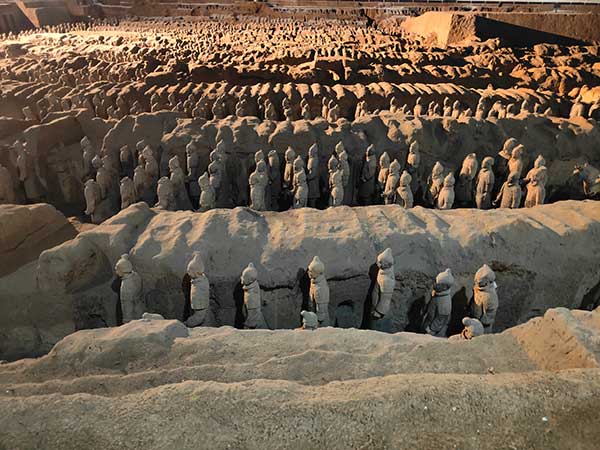
Terracotta Army: the Pinnacle of Ancient Sculptural Art
In 1974, the archaeological community in Shaanxi uncovered a discovery that shook the world—the Terracotta Army. Located within the mausoleum complex of Emperor Qin Shi Huang, this monumental find has been identified as funerary figures for the emperor. After years of meticulous excavation, archaeologists have revealed three pits containing over 8,000 terracotta warriors. Additionally, more than 180 burial pits have been discovered, including those holding bronze chariots and horses, stables, rare animals, stone armor, bronze birds, acrobatic figures, and various storage pits.

As the largest and most exquisitely crafted group of terracotta sculptures ever unearthed in China, the Terracotta Army exemplifies the extraordinary skill of ancient artisans and represents the zenith of sculptural artistry during the Qin Dynasty. Craftsmen ingeniously combined mold-making and hand-sculpting techniques: bodies were molded in sections, while heads—shaped with dozens of distinct molds to approximate human features—were individually refined by hand to ensure uniqueness. Pre-made details like ears, hair, hats, and facial features were then attached, infusing each figure with lifelike vitality.
Crafted from dense gray clay with balanced hollow and solid sections, the figures were fired at precise temperatures to achieve durability. After shaping, artisans applied vibrant pigments, enhancing their realism with colorful details.
From an aesthetic perspective, the Terracotta Army’s artistry is staggering.
Unmatched Realism: The soldiers mirror real human proportions, standing 1.7–1.8 meters tall, with anatomically accurate limbs, facial features, and period-authentic clothing and hairstyles. Their roles—infantry, cavalry, and more—reflect the Qin military’s disciplined organization.

Form and Spirit in Harmony: Each figure balances precise proportions, naturalistic poses, and expressive faces that seem to capture inner vitality, as if imbued with life.
Sculpture Meets Painting: Originally adorned with bright polychrome finishes, the figures showcase China’s ancient tradition of painted sculpture, a practice dating to the pre-Qin era and vividly preserved here.
The pits also contain terracotta chariots and horses, whose dynamic forms attest to the Qin Dynasty’s advanced craftsmanship. These discoveries solidify the era’s legacy in monumental sculpture, marking the maturation of Chinese sculptural art.

The excavation of Qin Shi Huang’s funerary complex stands as a testament to imperial grandeur, offering the world a priceless cultural and artistic treasure.
Portions adapted from Sun Zhenhua’s History of Ancient Chinese Sculpture (China Youth Publishing Group, 2011).